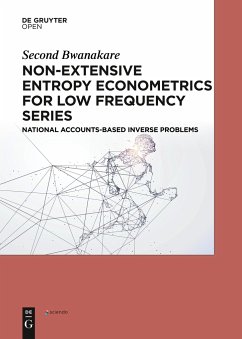The second edition of Non-extensive Entropy Econometrics for Low Frequency Series provides a new and robust power-law-based, non-extensive entropy econometrics approach to the economic modelling of ill-behaved inverse problems. Particular attention is paid to national account-based general equilibrium models known for their relative complexity.
In theoretical terms, the approach generalizes Gibbs-Shannon-Golan entropy models, which are useful for describing ergodic phenomena. In essence, this entropy econometrics approach constitutes a junction of two distinct concepts: Jayne's maximum entropy principle and the Bayesian generalized method of moments. Rival econometric techniques are not conceptually adapted to solving complex inverse problems or are seriously limited when it comes to practical implementation. Recent literature showed that amplitude and frequency of macroeconomic fluctuations do not substantially diverge from many other extreme events, natural or human-related, once they are explained in the same time (or space) scale. Non-extensive entropy is a precious device for econometric modelling even in the case of low frequency series, since outputs evolving within the Gaussian attractor correspond to the Tsallis entropy limiting case of Tsallis q-parameter around unity. This book introduces a sub-discipline called Non-extensive Entropy Econometrics or, using a recent expression, Superstar Generalised Econometrics. It demonstrates, using national accounts-based models, that this approach facilitates solving nonlinear, complex inverse problems, previously considered intractable, such as the constant elasticity of substitution class of functions. This new proposed approach could extend the frontier of theoretical and applied econometrics.
In theoretical terms, the approach generalizes Gibbs-Shannon-Golan entropy models, which are useful for describing ergodic phenomena. In essence, this entropy econometrics approach constitutes a junction of two distinct concepts: Jayne's maximum entropy principle and the Bayesian generalized method of moments. Rival econometric techniques are not conceptually adapted to solving complex inverse problems or are seriously limited when it comes to practical implementation. Recent literature showed that amplitude and frequency of macroeconomic fluctuations do not substantially diverge from many other extreme events, natural or human-related, once they are explained in the same time (or space) scale. Non-extensive entropy is a precious device for econometric modelling even in the case of low frequency series, since outputs evolving within the Gaussian attractor correspond to the Tsallis entropy limiting case of Tsallis q-parameter around unity. This book introduces a sub-discipline called Non-extensive Entropy Econometrics or, using a recent expression, Superstar Generalised Econometrics. It demonstrates, using national accounts-based models, that this approach facilitates solving nonlinear, complex inverse problems, previously considered intractable, such as the constant elasticity of substitution class of functions. This new proposed approach could extend the frontier of theoretical and applied econometrics.

